Zheng Luo
Multi-objective Aligned Bidword Generation Model for E-commerce Search Advertising
Jun 04, 2025Abstract:Retrieval systems primarily address the challenge of matching user queries with the most relevant advertisements, playing a crucial role in e-commerce search advertising. The diversity of user needs and expressions often produces massive long-tail queries that cannot be matched with merchant bidwords or product titles, which results in some advertisements not being recalled, ultimately harming user experience and search efficiency. Existing query rewriting research focuses on various methods such as query log mining, query-bidword vector matching, or generation-based rewriting. However, these methods often fail to simultaneously optimize the relevance and authenticity of the user's original query and rewrite and maximize the revenue potential of recalled ads. In this paper, we propose a Multi-objective aligned Bidword Generation Model (MoBGM), which is composed of a discriminator, generator, and preference alignment module, to address these challenges. To simultaneously improve the relevance and authenticity of the query and rewrite and maximize the platform revenue, we design a discriminator to optimize these key objectives. Using the feedback signal of the discriminator, we train a multi-objective aligned bidword generator that aims to maximize the combined effect of the three objectives. Extensive offline and online experiments show that our proposed algorithm significantly outperforms the state of the art. After deployment, the algorithm has created huge commercial value for the platform, further verifying its feasibility and robustness.
Generative Retrieval and Alignment Model: A New Paradigm for E-commerce Retrieval
Apr 02, 2025Abstract:Traditional sparse and dense retrieval methods struggle to leverage general world knowledge and often fail to capture the nuanced features of queries and products. With the advent of large language models (LLMs), industrial search systems have started to employ LLMs to generate identifiers for product retrieval. Commonly used identifiers include (1) static/semantic IDs and (2) product term sets. The first approach requires creating a product ID system from scratch, missing out on the world knowledge embedded within LLMs. While the second approach leverages this general knowledge, the significant difference in word distribution between queries and products means that product-based identifiers often do not align well with user search queries, leading to missed product recalls. Furthermore, when queries contain numerous attributes, these algorithms generate a large number of identifiers, making it difficult to assess their quality, which results in low overall recall efficiency. To address these challenges, this paper introduces a novel e-commerce retrieval paradigm: the Generative Retrieval and Alignment Model (GRAM). GRAM employs joint training on text information from both queries and products to generate shared text identifier codes, effectively bridging the gap between queries and products. This approach not only enhances the connection between queries and products but also improves inference efficiency. The model uses a co-alignment strategy to generate codes optimized for maximizing retrieval efficiency. Additionally, it introduces a query-product scoring mechanism to compare product values across different codes, further boosting retrieval efficiency. Extensive offline and online A/B testing demonstrates that GRAM significantly outperforms traditional models and the latest generative retrieval models, confirming its effectiveness and practicality.
Exploring structure diversity in atomic resolution microscopy with graph neural networks
Oct 23, 2024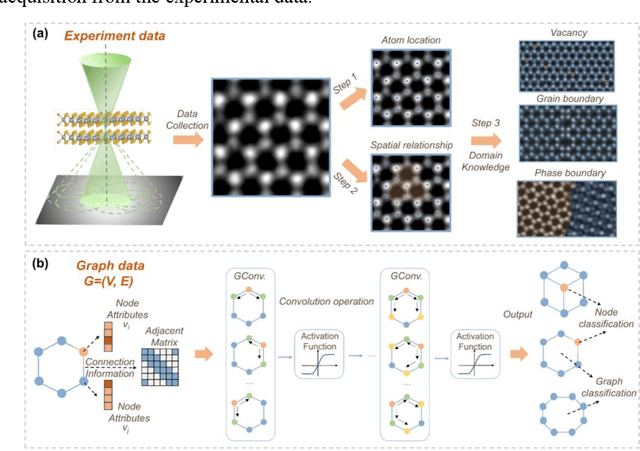
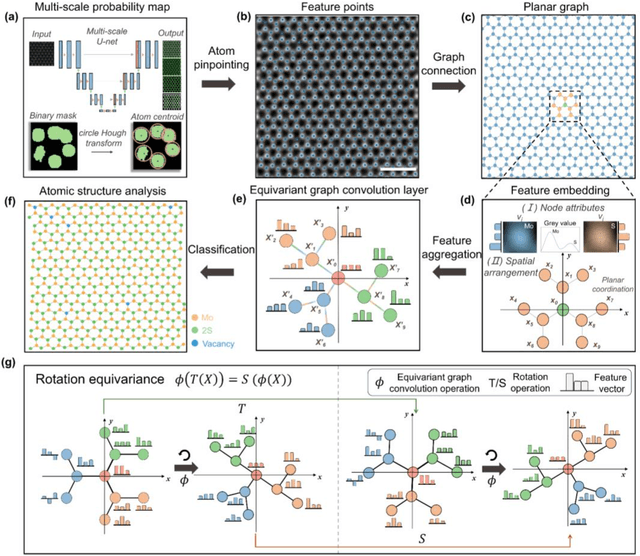
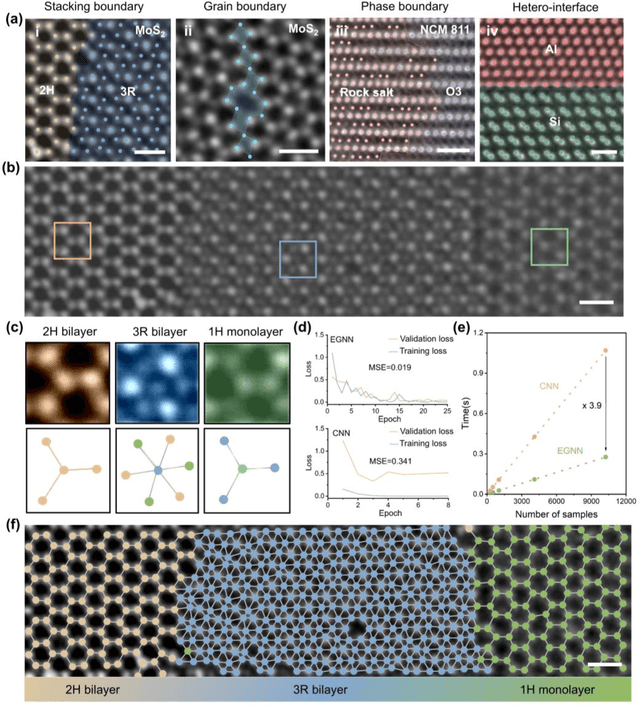
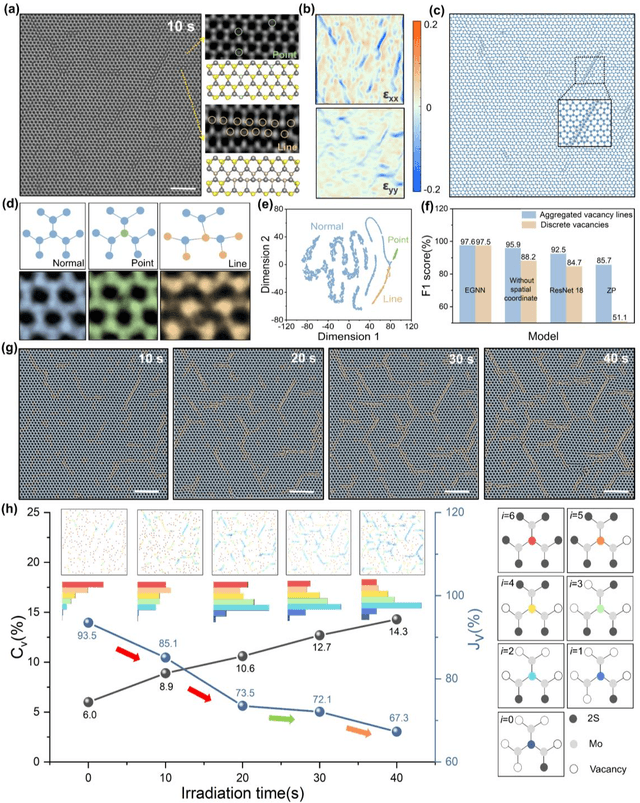
Abstract:The emergence of deep learning (DL) has provided great opportunities for the high-throughput analysis of atomic-resolution micrographs. However, the DL models trained by image patches in fixed size generally lack efficiency and flexibility when processing micrographs containing diversified atomic configurations. Herein, inspired by the similarity between the atomic structures and graphs, we describe a few-shot learning framework based on an equivariant graph neural network (EGNN) to analyze a library of atomic structures (e.g., vacancies, phases, grain boundaries, doping, etc.), showing significantly promoted robustness and three orders of magnitude reduced computing parameters compared to the image-driven DL models, which is especially evident for those aggregated vacancy lines with flexible lattice distortion. Besides, the intuitiveness of graphs enables quantitative and straightforward extraction of the atomic-scale structural features in batches, thus statistically unveiling the self-assembly dynamics of vacancy lines under electron beam irradiation. A versatile model toolkit is established by integrating EGNN sub-models for single structure recognition to process images involving varied configurations in the form of a task chain, leading to the discovery of novel doping configurations with superior electrocatalytic properties for hydrogen evolution reactions. This work provides a powerful tool to explore structure diversity in a fast, accurate, and intelligent manner.
Driving Scene Perception Network: Real-time Joint Detection, Depth Estimation and Semantic Segmentation
Mar 10, 2018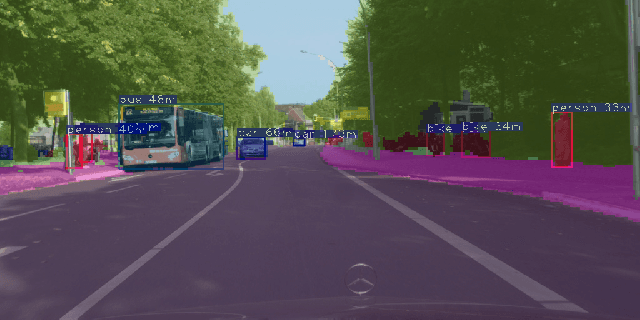



Abstract:As the demand for enabling high-level autonomous driving has increased in recent years and visual perception is one of the critical features to enable fully autonomous driving, in this paper, we introduce an efficient approach for simultaneous object detection, depth estimation and pixel-level semantic segmentation using a shared convolutional architecture. The proposed network model, which we named Driving Scene Perception Network (DSPNet), uses multi-level feature maps and multi-task learning to improve the accuracy and efficiency of object detection, depth estimation and image segmentation tasks from a single input image. Hence, the resulting network model uses less than 850 MiB of GPU memory and achieves 14.0 fps on NVIDIA GeForce GTX 1080 with a 1024x512 input image, and both precision and efficiency have been improved over combination of single tasks.
 Add to Chrome
Add to Chrome Add to Firefox
Add to Firefox Add to Edge
Add to Edge